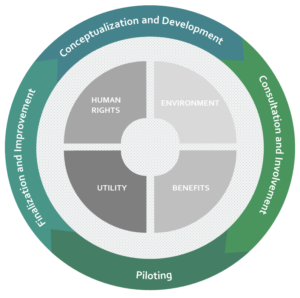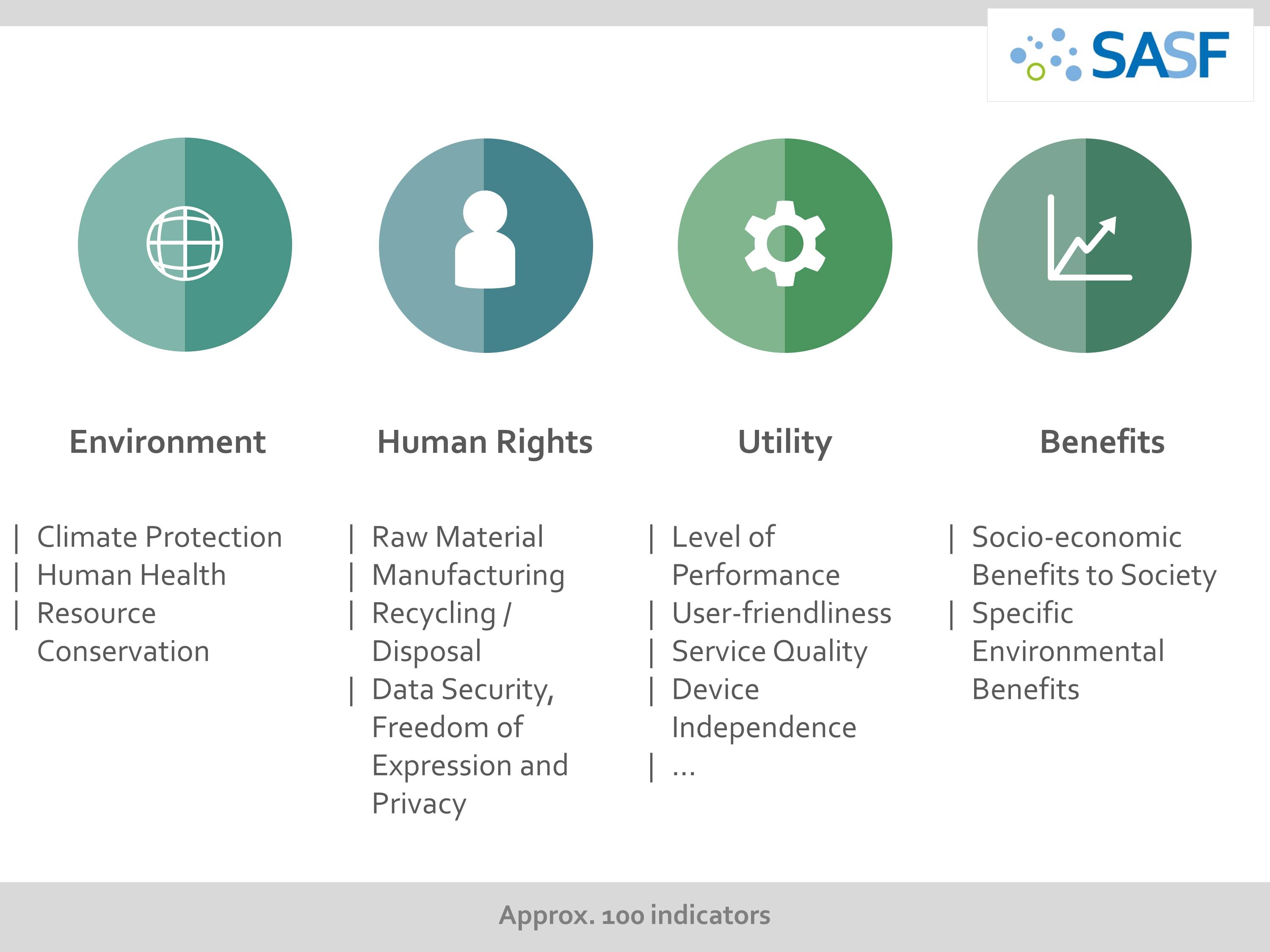The Project
 Initiated by GeSI and launched in February 2015, the Sustainability Assessment Framework (SASF) project set itself the ambitious goal of developing a comprehensive assessment tool to evaluate the sustainability performance of ICT products and services. The design of the framework was shaped through a transdisciplinary process which included workshops and webinars with GeSI members as well as external stakeholders. In late 2015 a pilot program was launched, in which a number of GeSI companies tested a draft version of the SASF for robustness and practicality within a business environment. In conclusion, SASF is a product assessment based on four pillars: human rights, environment, utility and benefits.
Initiated by GeSI and launched in February 2015, the Sustainability Assessment Framework (SASF) project set itself the ambitious goal of developing a comprehensive assessment tool to evaluate the sustainability performance of ICT products and services. The design of the framework was shaped through a transdisciplinary process which included workshops and webinars with GeSI members as well as external stakeholders. In late 2015 a pilot program was launched, in which a number of GeSI companies tested a draft version of the SASF for robustness and practicality within a business environment. In conclusion, SASF is a product assessment based on four pillars: human rights, environment, utility and benefits.
BENCHMARKING AND DEVELOPMENT
The design of SASF did not start from scratch. Prior to the development of the framework and its criteria, it was essential to understand how existing frameworks, standards and assessments are designed. The objective was not to gain a complete overview of a wide range of applied frameworks, but rather to identify best practices and gaps. For the benchmark analysis, seven existing frameworks were finally evaluated. During the SASF development, however, numerous other standards, frameworks, labels and tools have been additionally reviewed. Download the benchmark for more information.
The SASF is a comprehensive assessment tool: it covers environmental, human rights and utility aspects as well as benefits. The assessment is structured as a questionnaire and results in a product scoring system. Each aspect is subdivided into criteria, which again are divided into sub-criteria. Sub-criteria contain indicators, which form the basis of the questionnaire. The indicators are weighted according to their impact on sustainability performance.

A large number of ICT solutions have a positive impact on sustainability and contribute to achieving the UN Sustainable Development Goals (SDGs). The aspect Benefits aims to reveal this added value by highlighting the concrete impact of digital solutions on the SDGs. Moreover, specific environmental benefits such as travel and transport, as well as dematerialization are also incorporated. However, the final product scoring system does not include identified benefits. Considering the discussions with external experts, who stressed the fact that benefits and supply-chain risks should not be treated equally, the project group decided to evaluate benefits separately on a qualitative level.
STAKEHOLDER ENGAGEMENT: A KEY SUCCESS FACTOR
A vital success factor for the development of the Sustainability Assessment Framework (SASF) is the active stakeholder participation throughout a series of procedural integration steps. The stakeholder engagement provides important input for our decision-making and for the continuous improvement of the Framework.
In 2015 we organized stakeholder meetings as well as webinars, which focused specifically on Asian and American experts. The first meeting on April 28, 2015 in Brussels aimed to find common ground with external stakeholders regarding the project’s scope. The early involvement not only ensured the acceptance of the outcome, but materially strengthened the assessment through focusing on the most relevant topics to be considered in the evaluation
The second dialogue took place on September 25, 2015 at the GeSI office in Brussels. The aim of the workshop was to evaluate the proposed indicator set and furthermore to reflect on the weighting system.
For those international stakeholders who were not able to attend the meetings, webinars offered the possibility of an active exchange with GeSI representatives on the Framework development.
Related documents and information:
- Download Presentation 1. Stakeholder Meeting.
- Download Presentation 2. Stakeholder Meeting.
- Webinar Session 1 on June 25, 2015
- Experts: Andreas Harker (Swisscom) & Rasmus Priess (Oeko-Institut).
- Facilitation: Harald Utler & Christian Behrendt (Stakeholder Reporting)
- Watch Webinar Session 1
- Webinar Session 2 on June 25, 2015
- Experts: Danilo Riva (Telecom Italia) & Rasmus Priess (Oeko-Institut).
- Facilitation: Harald Utler & Christian Behrendt (Stakeholder Reporting)
- Watch Webinar Session 2
SASF is the result of more than 14 months of development work involving more than 20 external experts. As the field of ICT affects a wide range of stakeholders, stakeholder management in the SASF project aims to reflect this diversity: policymakers, investors, rating agencies, non-governmental and non-profit organisations, standardisation bodies and environmental protection agencies among others were and still are encouraged to share their perspectives, criticisms and claims regarding the development of the comprehensive framework with the project group.
EXTERNAL REVIEW IN 2016
The stakeholder engagement so far has been characterized by the selective involvement of key stakeholders. Due to the large scale of the SASF, an exhaustive analysis was not possible. In 2016 we wish to close this gap: previously involved ICT experts and key leaders will have the chance to externally review the latest version of SASF for a specific time period, and give detailed feedback on an indicator level.
PILOTS – PASSING THE FIRST STRESS TEST
SASF is a holistic tool which covers a wide field of impacts along the ICT value chain. In order to answer the questionnaire, companies are requested to gather specific information and data.
While the main task for the project team was to develop a comprehensive, modular tool, it had to be applicable by GeSI member companies as well. For this reason a pilot phase (December 2015 to February 2016) aimed to pre-test the applicability of a first draft version within a corporate environment. As a result, the participating companies confirmed that the SASF is a robust system. The pilots made clear that the framework provides additional value to companies using the tool, as it provides new insights on the overall sustainability performance of specific ICT products and services. In addition, the SASF was found to be comprehensive.
The participating companies were Deutsche Telekom, Huawei, Orange, Swisscom, Telefónica, and TIM (formerly Telecom Italia).
LATEST PUBLICATIONS
- #4 Project Status Report (Phase 2)
- #3 Final Project Status Report (Phase 1)
- #2 Project Status Report (Phase 1)
- #1 Project Status Report (Phase 1)
- Presentation 2nd Stakeholder Meeting
- Presentation 1st Stakeholder Meeting
- Webinar Session 2
- Webinar Session 1
- Benchmark Analysis
On behalf of the Global e-Sustainability Initiative (GeSI) the Sustainability Assessment Framework (SASF) was developed by the Oeko-Institut, Germany and Stakeholder Reporting. Oeko-Institut developed the overall systematic and structure of the SASF, including the criteria, indicators and weighting system, while Stakeholder Reporting managed the project including the stakeholder engagement process.
